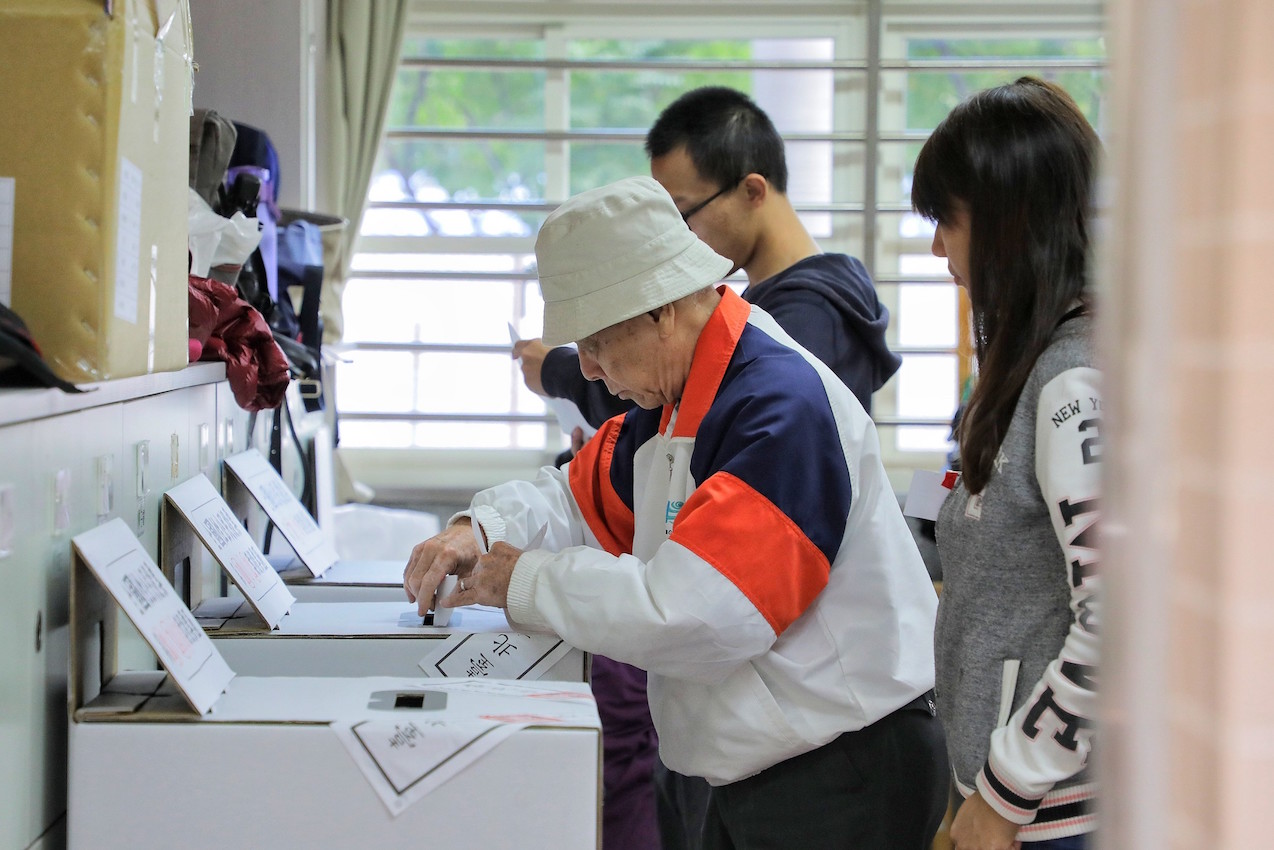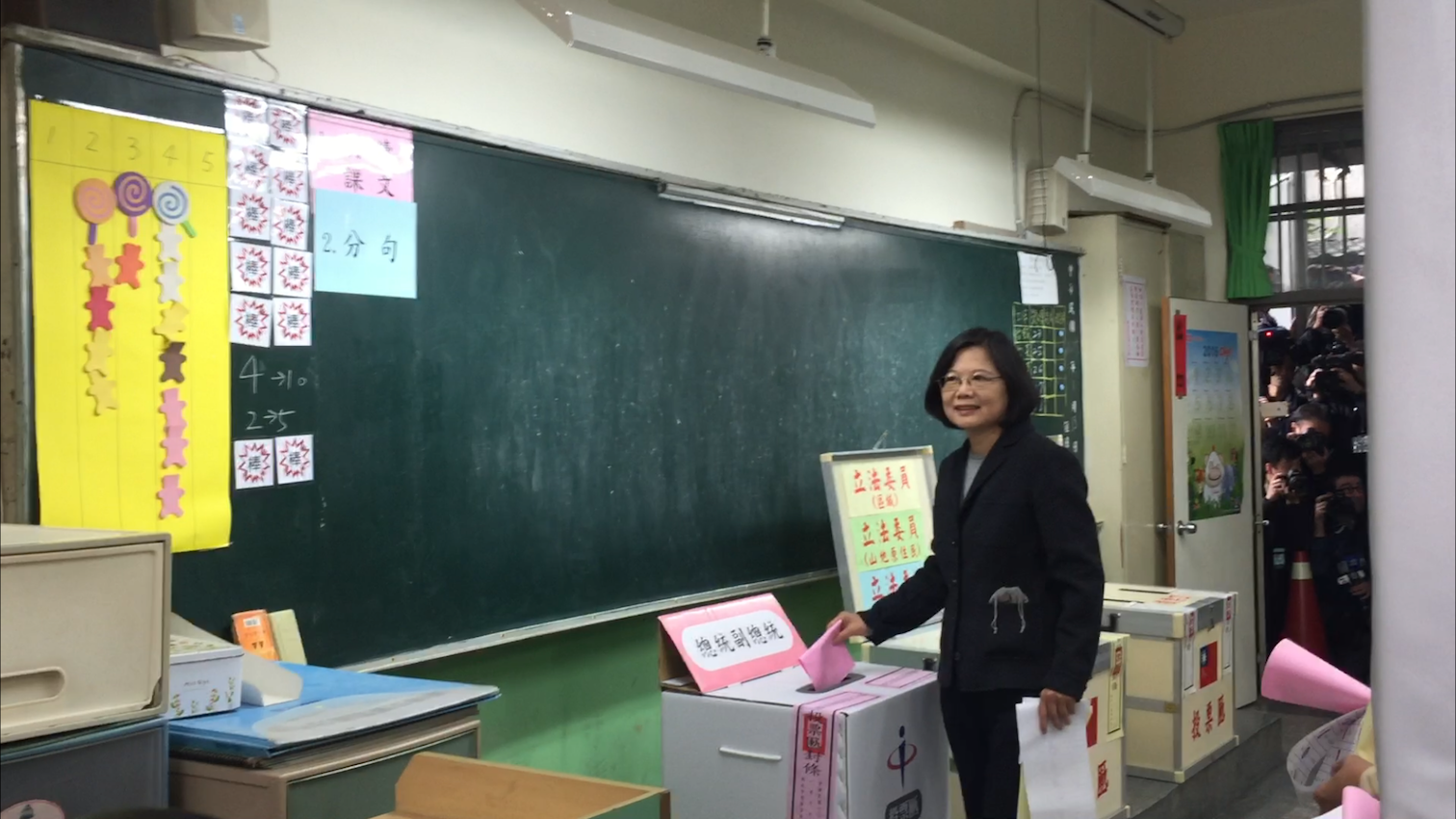by Brian Hioe
語言:
English
Photo Credit: 中國國民黨 KMT/Facebook
DEMONSTRATIONS ORGANIZED by the KMT on Sunday last week in Taipei prove ironic in several respects. The demonstration was against recent changes to the Referendum Act pushed into law by the DPP which will split which day that referendums are held on from the day that political elections take place, and make it so that referendums can only be held every two years. As such, KMT demonstrators claimed that “democracy was dead” during the rally and lashed out against the “dictatorial” DPP. The demonstration drew thousands.
As usual, claims that the DPP has fundamentally destroyed Taiwan’s democracy in any way or is enacting a “Green Terror” are hypocritical coming from a party that ruled over Taiwan in an authoritarian manner for decades, killing tens of thousands as part of its campaign of terror. The DPP itself is also the political party which emerged from Taiwan’s democracy movement.
 Voting during last year’s elections. Photo credit: Presidential Office
Voting during last year’s elections. Photo credit: Presidential Office
But the KMT has clearly found the claim that the DPP is anti-democratic a useful weapon, appropriating the DPP’s critiques of the KMT in order to use them against the DPP.
One can see the KMT’s appropriation of the referendum also to be the appropriation of a legal measure originally pushed for by the pan-Green camp. Namely, the pan-Green camp has long since pushed for a lowering of the benchmarks in the ROC constitution needed to hold a national referendum, claiming that benchmarks that needed to be met to hold a national referendum in Taiwan are prohibitively high. This was not only a demand of pan-Green traditionalists but also youth activists involved in the Sunflower Movement and civil society actors involved in progressive activism afterward.
The benchmarks that needed to be met to hold a referendum were referred to as a “birdcage,” with the Referendum Act labeled the “Birdcage Referendum Act”. The referendum was posed as a means of permanently resolving a number of national issues, including Taiwan’s de facto independence but lack of acknowledgement by the majority of the countries in the world, as well as other national issues such as whether nuclear energy should be used in Taiwan given that frequent seismic activity in Taiwan that could potentially lead to an event similar to the 2011 Fukushima disaster in Japan.
The DPP was successful in lowering these benchmarks in December 2017, though the changes to the Referendum Act do not allow for a referendum to be held on the name of the nation or matters of the ROC constitution. However, the KMT currently claims that in making further changes to the Referendum Act, the DPP has instituted an “Iron Cage” to limit when referendums can be held.
It is probable that the KMT partly hopes to generate the perception that the DPP reinstated the “Birdcage” entirely, as part of its claims that the DPP is anti-democratic. That being said, as pointed out by DPP politicians including Premier Su Tseng-chang, if the KMT had been so opposed to the “Birdcage Referendum Act” to begin with, it could have listened to the voices of progressive civil society and passed changes to the Referendum Act much earlier.
The KMT has in recent memory claimed that the DPP was planning on using the national referendum to dismantle the ROC and establish Taiwanese independence, as a means to mobilize ROC nationalists to action in support of the KMT.
But, again, this in spite of that the changes to the Referendum Act last year would not allow for the referendum to be held on issues regarding independence and unification, something that was highly upsetting to pan-Green traditionalists in the DPP, and one of the factors which led them to back former premier William Lai in a challenge to Tsai Ing-wen for the DPP’s 2020 presidential nomination with the view that the DPP had under Tsai lost its core values. Some of these pan-Green traditionalists are, in fact, also disappointed with the new set of changes to the Referendum Act, as contributing to what they view as the DPP losing its core values and the deterioration of the party’s internal democracy.
 Current president Tsai Ing-wen voting during last year’s elections. Photo credit: VOA
Current president Tsai Ing-wen voting during last year’s elections. Photo credit: VOA
Yet, perhaps in line with the appropriation of Sunflower Movement tactics by the KMT that one has observed since 2016, the KMT has learned to find the referendum useful for its own ends, starting in 2018 elections. The pan-Blue camp was able to use its superior financial resources and its deeply rooted mobilization network to use the referendum as a means to try force elements of its political agenda into law, and to use various single-issue causes to mobilize supporters and attack the DPP. Consequently, the pan-Blue camp mobilized voters against gay marriage, in favor of nuclear energy, and against food imports from Fukushima-affected areas, to push for the KMT’s support of nuclear energy, opposition to gay marriage, and nationalistic antagonisms against Japan.
That the referendum could be unduly affected by financial resources was most visible in the highly-funded campaigns against gay marriage that came from members of the pan-Blue camp and church groups. As money unduly influencing the course of elections is already an issue in electoral politics in Taiwan, one wonders whether the referendum was simply reinventing the wheel in this regard. And with pan-Blue actors using the referendum as a means to attack their political enemies, as a part of their electoral strategy, this should remind that a political referendum would never occur in a political vacuum, but stands to be influenced by electoral politics.
Nevertheless, the new set of changes is precisely intended to try and cut off the influence of electoral politics on the national referendum, through splitting electoral voting from voting on referendums. It remains to be seen if this will be successful. But, as is already visible, the KMT will seize on this as yet another political issue with which to attack the DPP.

